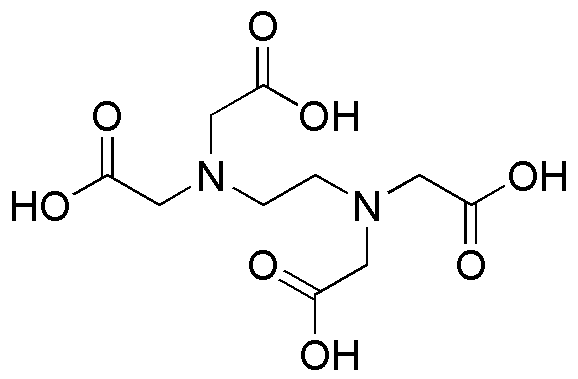Ethylenediaminetetraacetic acid is widely utilized in research focused on:
- Metal Ion Chelation: This compound effectively binds to metal ions, making it invaluable in various industries such as water treatment, where it helps remove harmful heavy metals from water sources.
- Pharmaceutical Formulations: In the medical field, it is used to formulate drugs that require stabilization of metal ions, enhancing the efficacy and safety of medications.
- Biochemical Research: Researchers use it in laboratories to study enzyme activity and protein interactions, as it can help control metal ion concentrations in biological experiments.
- Food Preservation: It acts as a preservative in the food industry by preventing metal-catalyzed oxidation, which helps maintain the quality and shelf-life of food products.
- Cosmetic Products: Ethylenediaminetetraacetic acid is included in skincare formulations to improve product stability and enhance the effectiveness of active ingredients by chelating trace metals.
General Information
Properties
Safety and Regulations
Applications
Ethylenediaminetetraacetic acid is widely utilized in research focused on:
- Metal Ion Chelation: This compound effectively binds to metal ions, making it invaluable in various industries such as water treatment, where it helps remove harmful heavy metals from water sources.
- Pharmaceutical Formulations: In the medical field, it is used to formulate drugs that require stabilization of metal ions, enhancing the efficacy and safety of medications.
- Biochemical Research: Researchers use it in laboratories to study enzyme activity and protein interactions, as it can help control metal ion concentrations in biological experiments.
- Food Preservation: It acts as a preservative in the food industry by preventing metal-catalyzed oxidation, which helps maintain the quality and shelf-life of food products.
- Cosmetic Products: Ethylenediaminetetraacetic acid is included in skincare formulations to improve product stability and enhance the effectiveness of active ingredients by chelating trace metals.
Documents
Safety Data Sheets (SDS)
The SDS provides comprehensive safety information on handling, storage, and disposal of the product.
Product Specification (PS)
The PS provides a comprehensive breakdown of the product’s properties, including chemical composition, physical state, purity, and storage requirements. It also details acceptable quality ranges and the product's intended applications.
Certificates of Analysis (COA)
Search for Certificates of Analysis (COA) by entering the products Lot Number. Lot and Batch Numbers can be found on a product’s label following the words ‘Lot’ or ‘Batch’.
*Catalog Number
*Lot Number
Certificates Of Origin (COO)
This COO confirms the country where the product was manufactured, and also details the materials and components used in it and whether it is derived from natural, synthetic, or other specific sources. This certificate may be required for customs, trade, and regulatory compliance.
*Catalog Number
*Lot Number
Safety Data Sheets (SDS)
The SDS provides comprehensive safety information on handling, storage, and disposal of the product.
DownloadProduct Specification (PS)
The PS provides a comprehensive breakdown of the product’s properties, including chemical composition, physical state, purity, and storage requirements. It also details acceptable quality ranges and the product's intended applications.
DownloadCertificates of Analysis (COA)
Search for Certificates of Analysis (COA) by entering the products Lot Number. Lot and Batch Numbers can be found on a product’s label following the words ‘Lot’ or ‘Batch’.
*Catalog Number
*Lot Number
Certificates Of Origin (COO)
This COO confirms the country where the product was manufactured, and also details the materials and components used in it and whether it is derived from natural, synthetic, or other specific sources. This certificate may be required for customs, trade, and regulatory compliance.


